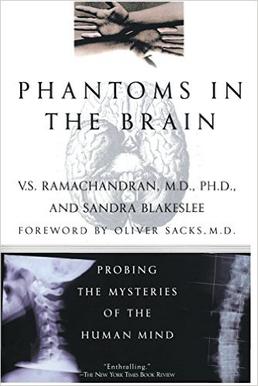Phantoms in the Brain
Phantoms in the Brain[edit | edit source]
Phantoms in the Brain: Probing the Mysteries of the Human Mind is a book by neuroscientist V. S. Ramachandran and journalist Sandra Blakeslee. Published in 1998, the book explores the complex and often mysterious workings of the human brain, particularly focusing on the phenomenon of phantom limbs and other neurological curiosities.
Overview[edit | edit source]
The book delves into the world of neurology, examining how the brain constructs our perception of reality. Ramachandran uses a series of case studies to illustrate how brain damage can lead to bizarre and fascinating conditions, such as phantom limb syndrome, Capgras delusion, and synesthesia.
Phantom Limbs[edit | edit source]
One of the central topics of the book is the phenomenon of phantom limbs, where amputees continue to feel sensations, including pain, in their missing limbs. Ramachandran explains this through the concept of neuroplasticity, where the brain's somatosensory cortex reorganizes itself after the loss of a limb. He describes innovative treatments, such as the mirror box therapy, which can help alleviate phantom pain by "tricking" the brain into perceiving the presence of the missing limb.
Neurological Syndromes[edit | edit source]
The book also covers a variety of other neurological syndromes that reveal the brain's inner workings. For example, the Capgras delusion is a condition where a person believes that a loved one has been replaced by an impostor. Ramachandran discusses how this might be due to a disconnection between the brain's facial recognition areas and the limbic system, which processes emotions.
Synesthesia[edit | edit source]
Another intriguing topic is synesthesia, a condition where stimulation of one sensory pathway leads to automatic, involuntary experiences in a second sensory pathway. For instance, some people might "see" sounds as colors. Ramachandran explores how synesthesia might provide insights into the brain's associative networks and the nature of creativity.
Impact and Reception[edit | edit source]
Phantoms in the Brain has been praised for its accessible writing style and its ability to make complex neurological concepts understandable to a general audience. The book has contributed to a greater public interest in the field of neuroscience and has inspired further research into the brain's adaptability and the nature of consciousness.
Related Pages[edit | edit source]
Search WikiMD
Ad.Tired of being Overweight? Try W8MD's NYC physician weight loss.
Semaglutide (Ozempic / Wegovy and Tirzepatide (Mounjaro / Zepbound) available. Call 718 946 5500.
Advertise on WikiMD
|
WikiMD's Wellness Encyclopedia |
| Let Food Be Thy Medicine Medicine Thy Food - Hippocrates |
Translate this page: - East Asian
中文,
日本,
한국어,
South Asian
हिन्दी,
தமிழ்,
తెలుగు,
Urdu,
ಕನ್ನಡ,
Southeast Asian
Indonesian,
Vietnamese,
Thai,
မြန်မာဘာသာ,
বাংলা
European
español,
Deutsch,
français,
Greek,
português do Brasil,
polski,
română,
русский,
Nederlands,
norsk,
svenska,
suomi,
Italian
Middle Eastern & African
عربى,
Turkish,
Persian,
Hebrew,
Afrikaans,
isiZulu,
Kiswahili,
Other
Bulgarian,
Hungarian,
Czech,
Swedish,
മലയാളം,
मराठी,
ਪੰਜਾਬੀ,
ગુજરાતી,
Portuguese,
Ukrainian
Medical Disclaimer: WikiMD is not a substitute for professional medical advice. The information on WikiMD is provided as an information resource only, may be incorrect, outdated or misleading, and is not to be used or relied on for any diagnostic or treatment purposes. Please consult your health care provider before making any healthcare decisions or for guidance about a specific medical condition. WikiMD expressly disclaims responsibility, and shall have no liability, for any damages, loss, injury, or liability whatsoever suffered as a result of your reliance on the information contained in this site. By visiting this site you agree to the foregoing terms and conditions, which may from time to time be changed or supplemented by WikiMD. If you do not agree to the foregoing terms and conditions, you should not enter or use this site. See full disclaimer.
Credits:Most images are courtesy of Wikimedia commons, and templates, categories Wikipedia, licensed under CC BY SA or similar.
Contributors: Prab R. Tumpati, MD

